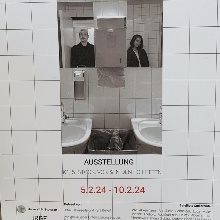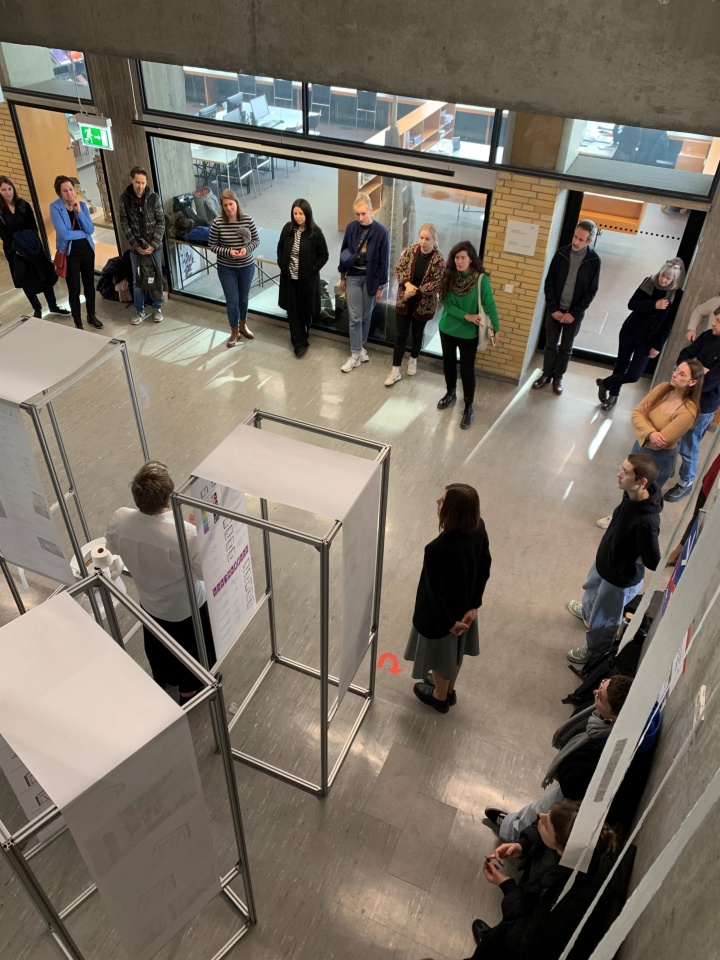It is uncommon for the aspiration for structural and socio-political advancement within the university to result in a new seminar. But that's what happened at the Institute of Spatial Conception and Principles of Design (IRGE) in the winter semester 2023/24. Titled 'All-Gender: Reflecting on the university's public restrooms' and under the guidance of lecturers Kyra Bullert and Alba Balmaseda, students from the Faculty of Architecture considered the question of how safe, sustainable and inclusive public toilets might be provided in buildings at the University of Stuttgart.
The demand for gender-neutral toilets in public buildings and workplaces is increasing, to ensure that not only men and women, but also intersex, transgender and non-binary people can visit a restroom and feel safe and comfortable.
Added value through additional functions
The results of these considerations from the architecture seminar are now on display in the corridor on the 5th floor of K1 (Keplerstrasse 11) until February 10, 2024. The five designs on display, which represent five different university buildings, make it clear why an inclusive and gender-neutral redesign of toilets requires something other than a mere rededication, for example through "new signs" on the door. From an architectural point of view, spatial solutions for gender-neutral toilets can be much more than just a location where everyone can do their business. The designs integrate a variety of ideas and create "added value" through additional possible uses for the rooms, such as barrier-free access for people with disabilities, baby changing and resting facilities and the integration of communal kitchens and shower cubicles.
"Simply adding new signs to the existing toilets at the university to make them gender-neutral is not legally possible, as a certain number is prescribed according to the number of users. It is impressive to see the creative proposals that the students have come up with to contribute to an inclusive place to study, research and work," explains Prof Silke Wieprecht, Vice-Rector for Diversity and International Affairs. And if construction work must be done here anyway, why not do it properly, i.e. with a "plus"? The students' ideas go beyond gender neutrality and ideas for additional functions. The "See and pee seen" concept, for example, renegotiates the conflict of intimacy in public. A gender-neutral toilet with a urine treatment system - to fertilize the surrounding garden and installed on a pedestal in a prominent location, namely the disused fountain in the city garden.
A widespread wish
"A lot of students were interested in the seminar. "To be honest, the topic didn't originate from the Faculty of Architecture; it was actually brought to us from an external source," explains Kyra Bullert at the exhibition opening. "The internal "need" to address the topic of "gender-neutral toilets" had already emerged a year earlier across several departments of the university. One of the catalysts, for instance, was the Institute for Natural Language Processing, represented by Prof. Sabine Schulte im Walde. In that building - which is only used internally by institute mmémbers - there was a desire for gender-neutral toilets. Schulte im Walde then found out what needed to be done to re-designate the rooms and ended up at the Office for Inclusive University Culture. The request was met with open arms. Division 8, Division 6, the Vice Rectorate for Diversity and Internationalization, the Inclusion Officer and the Board of Representatives for disabled persons/employees/students, and stuvus, continue to work together on this topic. The seminar, led by lecturers Kyra Bullert and Alba Balmaseda, received financial support from the University of Stuttgart's Diversity Fund 2023.



